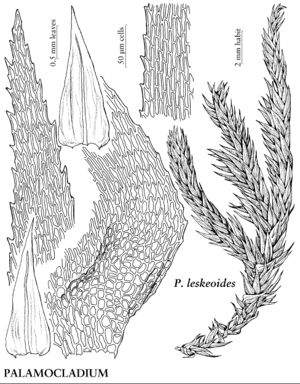Palamocladium
Flora 82: 465. 1896.
| Taxon | Illustrator ⠉ | |
|---|---|---|
 | Palamocladium leskeoides | Patricia M. Eckel |
Plants large, in moderately loose tufts, deep green to brownish or olive green. Stems creeping to ascending, moderately to very densely terete-foliate, irregularly pinnate, branches terete-foliate; central strand weak; pseudoparaphyllia acute; axillary hairs of 3–6 cells. Stem-leaves erect, imbricate, lanceolate-triangular, ovatelanceolate, or lanceolate, weakly concave, deeply plicate, or not plicate in slender plants; base slightly auriculate proximally; margins coarsely serrate; apex gradually tapered, narrowly acute, or somewhat acuminate; costa subpercurrent, slender, terminal spine small, inconspicuous; alar cells subquadrate, small, region of 10–15 × 5–8 cells; laminal cells elongate, relatively short, walls moderately thick; basal juxtacostal cells short-ovate. Branch leaves similar, somewhat narrower, somewhat shorter. Sexual condition dioicous or phyllodioicous; perichaetial leaf apex reflexed. [Seta redbrown, smooth. Capsule erect, reddish-brown, ovoid-cylindric; annulus separating by fragments; operculum long, gradually tapered. Calyptra naked. Spores 9–20 µm].
Distribution
sc, se United States, Mexico, Central America, South America, sw, e Asia, Africa, Indian Ocean Islands (Madagascar), w Pacific Islands, tropical to south temperate regions
Discussion
Species 3–6 (1 in the flora).
Palamocladium was included in Homalothecium by H. Robinson (1962), but this decision was not accepted by H. A. Crum and L. E. Anderson (1981) or H. Hofmann (1997). According to M. S. Ignatov and S. Huttunen (2002), these genera belong in different subfamilies. Palamocladium can be recognized by narrow, rigid, and, when well developed, plicate leaves. Although these characters are the same as for Homalothecium, Palamocladium appears superficially different, as its leaves are erect to somewhat spreading when dry whereas more appressed in Homalothecium. The plants are olive or brownish and rather oily; in Homalothecium they are rich golden and rather silky. Microscopically, the coarse serration in the acumen is helpful in species recognition, as well as the extensive groups of small alar cells forming opaque areas.
Selected References
None.
Lower Taxa
"long" is not a number."broad" is not a number.